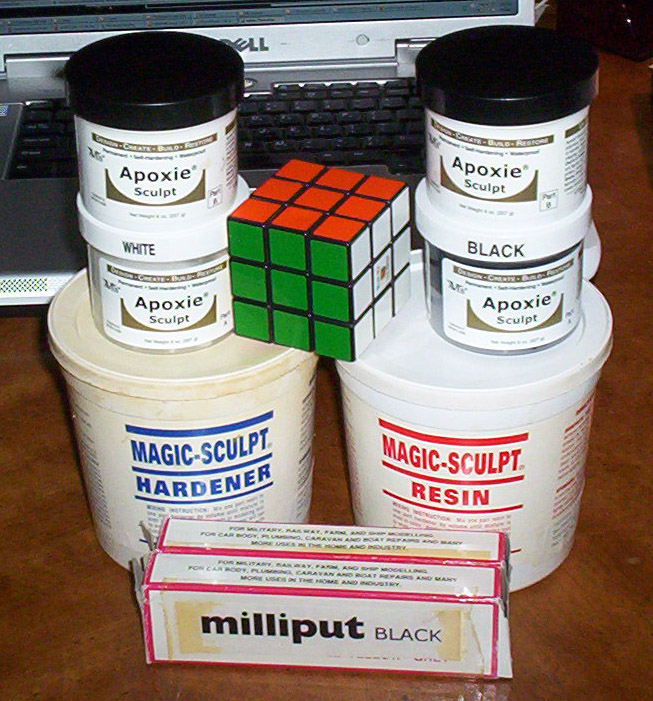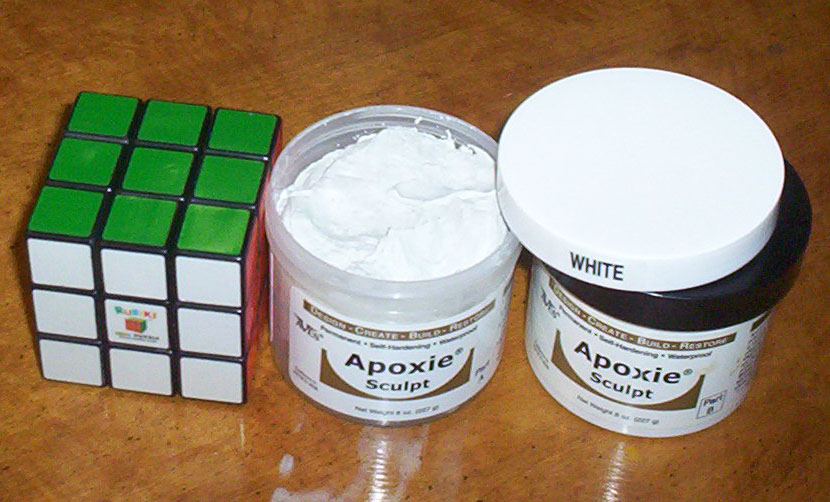

With this simple reference page I hope to answer some questions about which putty is right for you. This is not a scientific test or even a particular rigorous exercise, but hopefully it will steer people in the right direction regarding the use of two-part epoxy putties.
The use of epoxy putties seems to be popular among many hobbyists as well as taxidermists. The consistency of most epoxy putties is very close to that of modeling clay, so is generally easy to work with. The epoxy putties here generally start a bit soft but start hardening as they cure and become easier to carve and cut over the course of about an hour or two. Usually people start by roughing a shape when the epoxy putty is soft and then as the putty cures they shape the part more precisely and use tools to create detail. All of the putties listed here are easily smoothed and manipulated with a little bit of water.
Epoxy putties also do not require heat to cure and will even cure under water if not diluted to be washed off. They also do not shrink so are ideally suited to making exact shapes. They are quite durable but can be a bit on the brittle side if the shapes are really thin or narrow. They also stick very well when first mixed but slowly lose their adhesion. Overall they are an excellent way to fill gaps and make some shapes like masters for molding. However they can make for heavy custom puzzles if a lot of putty is employed.
As a bonus, the epoxy putties here have very little odor (slightly earthy in smell) and shouldn't require any fancy ventilation. A very small percentage of people have reported that epoxy putties are skin irritants so people are advised to consider using some sort of glove when handling epoxy putties. Personally though I have not experienced any issues and I have handled quite a bit of epoxy putty over the years. I'm sure not as much as a taxidermist, however.
The putties I have tested personally include:
Milliput Superfine White (www.milliput.com)
Milliput Black (www.milliput.com)
Magic Sculp Natural (www.magicsculp.com)
Apoxie Sculpt Black (www.avesstudio.com)
Apoxie Sculpt White (www.avesstudio.com)
Putties yet to be tested:
Magic Sculp Black (www.magicsculp.com)
Apoxie Sculpt Super White (www.avesstudio.com)
Quick Overview
Milliput Superfine White - A very white, very fine putty. Sets to a very pure white color but any contaminants in the putty will likely show up easily on the surface. The putty is somewhat stiffer to work with compared to the other brands but still very workable although it may leave you with cramped fingers in large batches.
Milliput comes inside a box in two individually wrapped sticks that weigh 4 ounces together. The Superfine White is generally more expensive than the other colors and is usually priced around $8-17, or $32-68 per pound. I've also had some issues with Milliput's longevity. Despite the individually wrapped sticks, it seems that over Time (a period of about 1-2 years) the two sticks outgas slightly and with Time they get harder and develop a "crust." White will be yellowish on the outside although if you slice off those portions you can still use the parts in the middle.
If you're planning on working with puzzles however, you're better off getting something that's pre-pigmented o help reduce the labor painting the finished puzzle. Milliput Superfine White is also their most expensive putty for their already somewhat expensive lineup of products.
Milliput Black - Milliput offers a black putty but is not advertised on their website. It can be found for sale here and there however or directly by contacting them at their website. The price of the black Milliput is about on par with the rest of their products and otherwise has similar properties to Milliput Superfine White.
Magic Sculp Natural - Magic sculp is an excellent epoxy putty for puzzle construction. It is initially easier to knead and sculpt than Milliput but as the putty sets up it gradually increases in hardness, making it very comparable to the feel of Milliput.
Magic Sculp is very economical, selling for about $9-10 for a one pound quantity that comes in two separate buckets with virtually no chance of incidental contamination (Picture at the top shows off the 5 pound quantity). It also appears to store well without Milliput's familiar "crust" after a couple of years of storage.
If Magic Sculp has a drawback, it's that it does not come in various colors aside from a limited selection of earthy hues. Also availability of colors other than its natural neutral hue might be an issue and the home page gives no indication of the availability or even the existence of the other varieties.
Apoxie Sculpt Black - This is currently my favorite epoxy putty to use when I need to shape/fill/mold pieces for black puzzles. It is easy to work with, on par with Magic Sculp, and seems to share almost identical properties.
Apoxie Sculpt comes in separate containers much like Magic Sculp, to prevent contamination. The price for Apoxie Sculpt is about $12-13 per pound of epoxy putty, not much more than Magic Sculp. Not to mention Apoxie Sculpt comes in 12 colors, which brings about some interesting possibilities for future puzzle builds.
Magic Sculp Black - Untried and no reference to it on the official website.
Apoxie Sculpt Super White - Untried. Price for their "Super White" is about 80% higher than their regular white or colors. Price of $20/pound amount (as listed on their website) is still considerably cheaper than the average price of Milliput.
The Bottom Line 2006/09/07:
If you're going to paint the final sculpt: Magic Sculp in natural color is the winner. It's the least expensive putty of the lot and it is just as good as those others for all intents and purposes. It stores well and is easy to work with. Plus it's readily available.
If you want black pieces: Apoxie Sculpt in black. It's a little more expensive than Magic Sculp but well worth the Time and trouble you save by having a pre-colored epoxy putty. I would recommend it even if you're planning on painting the pieces black because as the paint wears off from use the puzzle will still remain a black shade. However, pending evaluation of Magic Sculp in black, the recommendation may change.
If you want white pieces: Milliput Superfine White. While expensive and with a somewhat short shelf life, its very bright white color can't be denied. However, this is also pending evaluation of Apoxie Sculpt in their new Super White which is about 80% pricier than their regular putties yet still far cheaper than Milliput (by at least half the price).
I really like Magic Sculp and I still use it for some non-puzzle applications (I use it to fill the bases of miniatures, for example). I'd really like to try some Magic Sculp in black eventually. If the black is "black" enough then I suspect it will become my product of choice for puzzle sculpts.
